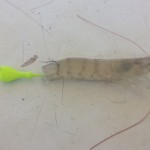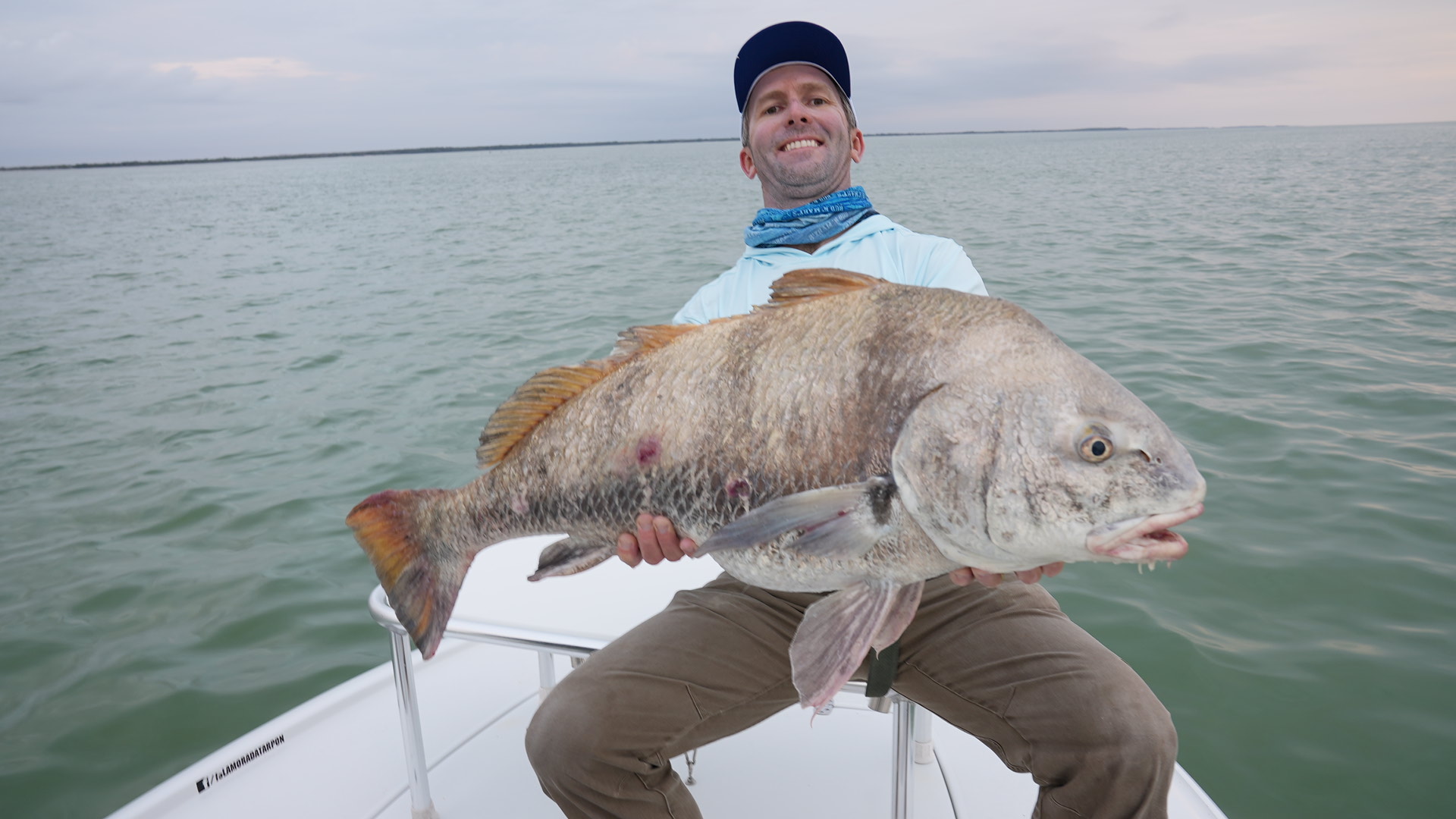Fishing with live shrimp in the Florida Keys is probably the most popular style of fishing in the area. Just about every bait shop throughout south florida carries live shrimp. These shrimp are caught in areas of the gulf and atlantic by trawlers who consistently net them and then truck them to local area bait shop early in the morning. It is one of the staples of our fishing industry and without them it would make the life of an islamorada fishing guide very tough! Just about everything eats shrimp so it is the go-to bait for us. Of course certain baits work better for certain things depending on a variety of conditions, however we bring live shrimp along on just about every charter. In Islamorada itself we do not have a big run of shrimp consistently, so we rely on trawlers who go out closer to the mainland and bring them down to us. In the winter time though with the right conditions (cold front coming in), they will run and you can catch shrimp in islamorada. So we will get down to the basic of buying, caring, and using shrimp for bait. Winter time we get the largest shrimp and with the cooler water temperature, everything in the backcountry just about eats them as well as on the patch reefs. Summer time is often a tougher time as the shrimp are usually very small, and you may be better off trying to catch other forms of live bait or even using artificials in some cases. [sociallocker id=”692″]
Live shrimp vs. frozen shrimp
You can always buy frozen shrimp as they are packaged and kept in freezers to sell. Though in just about every situation, live shrimp or fresh dead shrimp is going to be better. It is going to have more consistency as frozen shrimp often gets mushy and falls off the hook easily. It will also have better scent. Depending on what you are fishing for, also having a live shrimp that kicks is going to be much more appealing to a predator fish. Now if you are fishing for things such as yellowtail on the reef, frozen shrimp actually can be just as good as you are often just using a tiny bit of meat from the shrimp to hide the hook in. Though in general, live is better followed by fresh dead, then frozen.
Keeping live shrimp live
A nice thing about shrimp is they are fairly easy to keep alive for your days fishing. They usually don’t live for much more than a day or so, but of course you can put them on ice for the next day and again fresh dead in many cases is just as good as live. To keep them nice and lively, the best thing is to have a bait well that pumps fresh water in. This recirculates the water helping to keep the temperature cooler as well as brings in fresh oxygen. In the fall and winter, a simple aerator is all that is required. In summer when the water is very hot though it will help to recirculate the water to keep it cooler. If you keep them in a bucket without any form of oxygenation they will die eventually, so you can either buy a battery aerator or use oxygen pellet stones. Though air pellet stones will only last for an hour or so. If your fishing from land another option is a bucket with tiny holes drilled in it, you can leave this in the water that way fresh water is circulated, and you just pull it out when you need to put a few shrimp in your bucket you keep with you for fishing. These are sold in many tackle shops and known as a flow-troll bucket or something similar. The lesser amount of shrimp you keep in a bucket with no aeration, the longer they will live. So you can keep a few shrimp in your bucket with only water, and once they are gone pull the rest out of the bucket in the water, and that way keep them nice and lively for your fishing.
How to fish with shrimp in Islamorada
I’m often asked the best way to hook a live shrimp. Well it depends on what you are fishing for and how you are fishing. Some things to consider are whether it matters if the shrimp is actually live looking or not. Obviously if the shrimp is dead that won’t matter. Also if there are lots of fish, can they easily steal it off the hook. These methods will work with both J or circle hooks, as well as with jigs or standard hooks.
Standard tail hook shrimp rig
Our most classic go-to rig is usually a small jighead (1/4 oz is most common) with a shrimp hooked through the tail. Simply pinch off the tail and then start the hook through the tail end. Come out either through the belly of the shrimp or the back. The back is often better as it then goes through the shell which may make it stay on there better. This rig works well for jigging and the bait stays on the hook well. Just make sure that the shrimp doesn’t jig in a weird fashion, such as spinning around in circles. This will likely discourage fish from biting it. This will work for everything and is often the best for thing such as snapper, trout, mackerel, etc… If your using a regular J-hook, a Bait Saver style hook is best as it has small barbs to help keep the shrimp positioned correctly.
Horn hooked live shrimp rig
The other main way we hook shrimp is through the head. There is a ‘sweet spot’ just behind the horn on their head but in front of their heart (the big black spot). If you go through the heart the shrimp will die and you will lost the lively effect which is the point of this style. Try to get it perfectly lined up in the center, and hook from the bottom coming out the top. This is a good presentation for more picky gamefish such as snook or tarpon. The shrimp can freely flinch it’s tail which often excites a hungry gamefish. However if there are lots of ‘picker fish’ around it is much easier for them to steal shrimp off in this fashion. This works well with a jighead, or often we fish with a tiny bobber and a regular j-hook with a tiny split shot near the hook. This way you can drift the shrimp around mangrove shorelines etc… and simply watch for when the bobber goes down to indicate a strike.
Floating shrimp rig
Most of the time shrimp fishing in Islamorada you are wanting the shrimp to sink down in the water a bit. This would be using a jig or a regular hook with a split shot or sinker attached. There are exceptions when floating a shrimp may be a better choice. Snook and tarpon for instance are surface feeders so sometimes if you are wanting to throw a live shrimp floating on a cork it may work better. You can drift mangrove edges or areas of structure (bridge, etc…) in this fashion. For this rig a small bobber is usually attached maybe 3 feet up from the hook and this way the shrimp is kept floating. Now sometimes you may still attach a small split shot near the hook, or even still use a small weighted jighead, to let the bait sink down a little bit, but obviously not continuously until it hits the bottom. You’ll have to play with the presentation but it is something to consider in certain situations.
About leaders and such
Our typical leader size for the backcountry fishing with shrimp in Islamorada is 30# test. I prefer fluorocarbon as it is a bit stronger than regular mono, plus in certain areas where the water is clear it is tough for fish to see. On the patch reefs we often go down to 20# or even 15# test. For things such as snook or small tarpon we may go up to 40# as they can go through lighter leader. Give yourself a couple feet of leader at least. We fish a lot of braid and the best way to rig is usually to double the braid with a spider hitch. Then tie your leader with an albright knot to the doubled braid. Then use a simple uni, clinch, or whichever knot you prefer to tie the hook or jig to the leader. Most fishing we do you are wanting the shrimp to sink down so a jig head or split shot near the hook is preferable. It will also help you get some weight on the bait to make casting easier. In general a 1/4 oz is good for most fishing in the everglades areas and patch reefs. If the current is really hard you may require more. If your fishing a bait in a rod holder and leaving it sit, I often use a 1 oz sinker that slips and goes straight to a circle hook. Fish will hook themselves with this setup and you can cast it far, plus it is enough wait to usually hold bottom wherever you put it. Sight fishing in shallow water the rules may change depending what you are fishing for, obviously the more weight you use the louder the splash when you cast, so you may have to lead the fish more. One general rule of thumb if you see fish and cannot catch them, a better presentation is all you can usually do. That means lighter leader, smaller hook, and perhaps a livelier bait on the hook.
Chumming with shrimp
In some areas especially on shallow patch reefs, hanging a traditional chum block in the water is not always a good idea. It can bring in ‘junk fish’ such as grunts, baby snapper, chubs, etc… that just grab your bait before anything else has a chance to do it. Chopping up some of the dead, smaller shrimp into tiny pieces can work well in these instances. It can help bring in better fish without attracting the junk. Saving dead shrimp from a previous days fishing works well for this, or even buying a bag of frozen can sometimes work in this situation too. In other cases such as in the backcountry, sometimes chumming with just live shrimp can help. If your fishing around mangrove islands or shorelines, throwing a few live shrimp out can spark up snook or redfish that are hidden in the trees and entice them to bite the next bait you throw to them on a hook. Obviously you can go through your bait in a hurry, but if you are fishing a spot that looks really good it may help to throw a few live shrimp out if you are not getting a bite.
- Live ‘horn hooked’ shrimp on jig
- Standard tail hook shrimp with jig
[/sociallocker]
Capt. Rick Stanczyk
305-747-6903
rick@fishingislamorada.com




